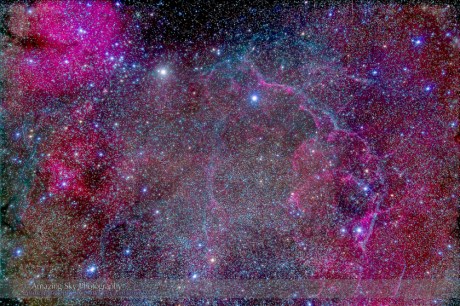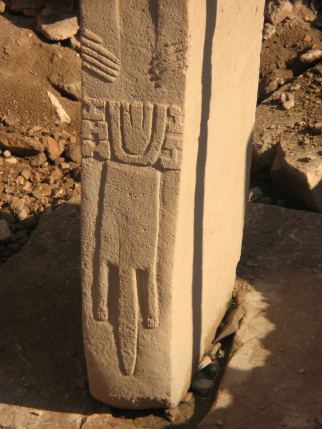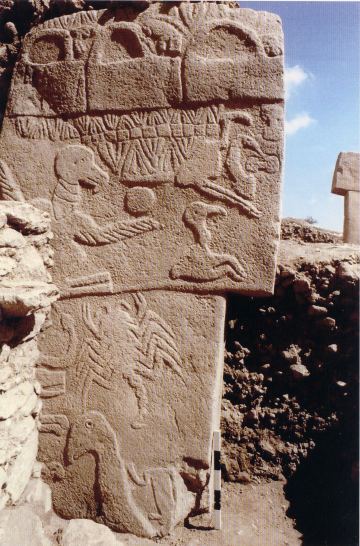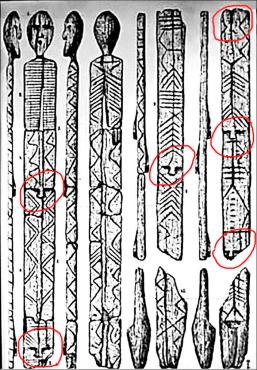Researchers say data from IceCube Neutrino Observatory at the South Pole indicate cosmic rays zapping Earth at the South Pole are coming from particular locations, rather than distributed uniformly across the sky.
Stefan Westerhoff of the University of Wisconsin and team used the observatory, buried under a thick layer of ice, to create a comprehensive map of the direction of cosmic rays in southern skies. The device detects elementary particles such as muons and neutrinos.
The cosmic ray source is 800 to 1,000 light years from Earth in the Vela supernova remnant. The massive star that formed this structure blew up between 11,000 and 12,300 years ago, astronomers believe.

Astronomers also believe Vela left at its core a pulsar-class neutron star, which has the density of an atomic nucleus spinning on its axis 10 times per second.
I would argue with that, EU provides more plausible explanations, but that is not the point, except to recognize estimates of when Vela occurred are based on those assumptions.
Astronomers also believe cosmic rays from such distance are buffeted by magnetic fields, lose all direction and should appear evenly from all parts of the sky. That’s not what they observed.
Felix Aharonian of the Dublin Institute for Advanced Studies in Ireland and colleagues suggested a “tube of magnetic field lines” between the source and our solar system, a funnel of cosmic rays. Aharonian scoffs the theory is highly speculative.
Others propose magnetic re-connection is accelerating local cosmic rays to energies in the TeV range and beaming them towards Earth. “It implies that we have a Tevatron in the solar system,” says Aharonian, referring to the particle accelerator at Fermilab. “That’s also crazy, but it is at least less crazy than other explanations.”
No it isn’t. What’s crazy is Felix sees an expected EU phenomena and doesn’t get it.
Vela may be 800 light years away, but it’s in our galactic neighborhood. By “tube of magnetic field lines,” Aharonian means a Berkeland current. He doesn’t use the proper terminology lest he give credence to a theory that actually explains what’s being seen.
I discovered Electric Universe because of interest in events that occurred at the end of the last ice age. Around 10,900 BC, as the earth slowly warmed from the last glacial period, the climate suddenly reversed. Glaciers expanded and the Earth suffered a relapse into deep freeze, killing most megafauna.
Then, in 9,700 BC, the cold stopped and Earth warmed – very suddenly. The 1,200-year period is called the Younger Dryas (YD) after the arctic flower that bloomed effusively, spreading pollen throughout the thick, dusty, wind-blown sediments of the period.
Substantial evidence indicates YD was caused by comet or asteroid impact on the North American ice sheet. Tell-tale nano-diamonds at the boundary marking YD sediments heavily support this. Climate change was rapid, but occurred over centuries, also consistent with impact theory.
The end of the cold is a bigger mystery. Evidence shows it occurred in less than three years – and perhaps it happened all in one, very bad day. I have a notion Vela was involved.
Making The Vela Connection

Item 1 – Dr. Anthony Peratt identifies prehistoric petroglyphs with extreme aurora events. This is a significant clue to the past. It’s also a clue to the workings of our solar system. Peratt’s work is clear. A gigaampere event lit up the southern sky with amazing aurora seen worldwide and recorded in stone.
Item 2 – Dr. Heinrich Svensmark theorizes a high energy cosmic ray connection to cloud formation and correlates ice ages with the position of the solar system within the galactic plane, causing increase in cosmic rays due to EU recognized phenomena. He has previously proven a connection for cosmic ray-ion-cloud formation in cloud chambers.
Item 3 – Dr. Robert Schoch theorizes a significantly large CME, or solar flare may have caused the YD climate change consistent with EU theory. He has previously shown erosion of the Sphinx makes it thousands of years older than thought, and perhaps dates to the YD period.

Item 4 – Vela theoretically went supernova in the period of the YD, although dating is based on neutron star theory, which EU does not support. The dating is based on frequency of the pulsar. EU theory predicts pulsars to be the flickering remains of a massive z-pinch short-circuit, presumably ending the life of a star, not a neutron star rotating ten times per second.
Item 5 – Vela is still blasting us with cosmic rays through Birkeland filaments in the Milky Way, as discussed in the opening. If that connection were open when the event occurred, the highest energy light-speed particles, gamma and x-ray would hit the heliosphere through a focused channel, not diffuse in space.
EU predicts these currents exist between stars in the galaxies and between galaxies in the Universe. It suggests they are not randomly connected, but linked electromagnetically. The sun would necessarily respond to the extra energy. This provides a mechanism for Dr. Schoch’s CME, or flare event.
This may be weak correlation, but there is a beautiful framework of EU phenomena we have observable evidence to study. Let’s see if we can strengthen the correlation.
“Squatter man”
Petroglyphs are hard to date. Their age can only be inferred from the age of artifacts found in association. Weathering, patina, lichen growth are only comparative measures…it’s never certain.
Furthermore, plasma events may have occurred many times in pre-history, and the rock art may record several events. Hopefully, evidence will emerge. Nevertheless, there is one point in time when it may be possible to correlate.

Item 6 – An article in Journal of Archaeological Science, by paleo-climatologist Larry Benson dates Nevada petroglyphs from radio carbon dating coatings on the rock. His study indicates they were made between wet periods when the rocks were submerged, which he correlates with age of strata in the lakebed to have occurred between 8,000 and 12,800 BC. Pictures on his website clearly show the petroglyphs portray plasma instabilities, including everyone’s favorite “squatter man.” The researcher claims it to be the oldest dated glyph in North America.
Item 7 – At Lapa do Santo, Brazil archeologists uncovered a petroglyph in undisturbed strata. By radio carbon dating material and other confirming test in the strata they determined the glyphs age to be 8,000 to 10,000 BC. The glyph depicts a Peratt instability of the “squatter man” variety. Researchers claim it to be the oldest dated glyph in South America.
Item 8 – Gobleki Tepi, Turkey is the worlds oldest megalithic structure firmly dated. It was manually covered with dirt and remained that way for thousands of years. Its beginning of construction is dated to roughly 10,000 BC. The exquisitely sculpted columns depict a variety of animal forms. Some of these, if not all, are slightly morphed characterizations of plasma displays artistically portrayed as birds, beaver pelts, geometries and other figures.
Item 9 – The Shigir Idol, a very well-preserved carved wooden totem found in a peat bog in the Urals is the oldest wooden statue in the world. Meticulous dating indicates it was constructed circa, 9,000 BC. It’s carvings depict the same grids, wavy lines, stacked diamonds, snakes and other images typical of the Peratt instability class of petroglyphs.

Each of these represents the oldest know and reliably dated artifacts clearly showing Peratt instabilities (that I am aware of.)
Artifact dates are within a common set between 9,000 and 10,000 BC.
Vela is dated to 9,000 to 10,300 BC.
The YD warmed in 9,700 BC.
They are smack-dab in the same ballpark.
I rest my case. It’s the best I have at the moment. EU predicts the possibility, science backs-up the dates, and I think it is an opportunity to learn more following this train of thought.
Just consider, these petroglyph images are a million in number on every continent except Antarctica. If one particular year, decade, or century can be identified when the events occurred, we have a global survey of the people and where they were and what they witnessed at the time. That would lead to better interpretation of every other bit of pot sherd and bone discovered, every snippet of myth and spiritual belief.
Whether Vela was the cause, whether that resulted in a solar flare, or a direct cosmic bombardment of Earth, or both, I think we have an event recorded from 9,700 BC that caused the Earth to warm rapidly, glaciers to melt in torrential floods and storms unlike any seen since. Many legends and myths around the world also support this.
The Kachinas in the sky must have frightened ancient man to the core. Were those who pecked the images they saw in the southern sky into rock survivors, or were they the ones trying to worship the aurora while lucky individuals sat under the rocks.

There is more evidence out there. Mainstream archeology seems to be deaf to the science of Peratt’s work. If you glanced at any of the links you’ll see that outside of the EU/Plasma community it is not mentioned. It’s over a decade since Peratt’s paper published and archeologists are still interpreting these figures with blinders on – as regional culture based phenomena, without seeming to know, or acknowledge these are found around the world.
They continue to blunder on, interpreting them as cultural icons on which they base absurd migratory assumptions, shamanistic psychotropic visions seen across a shared human consciousness, or proto-language script.
Well, it is the latter if you consider rock panels as catalogs of things witnessed, which is how I see it. I believe they witnessed and recorded on rock as they watched, and reproduced the images, applying they’re own interpretations as art at Gobleki Tepi, on the Shigir Idol and as we still do today.
These images are on petroglyphs, intaglios and artifacts in every part of the world except Antarctica. There are more examples that can yield dates out there, and the information may already be in someone’s knowledge. If you know of anything, please e-mail, or leave a comment. I am interested in any information that can lead to dating an artifact, petroglyph, pictograph or intaglio that depicts Peratt instability imagery.
And by the way, has anyone checked on the status of Betelgeuse lately?
If you have read this entire post but have not read Dr. Peratt’s paper, it is at this link. If you don’t know about EU, follow Electric Universe. Read my Thunderblogs.
AD Hall
Author “Lapse of Reason”

PS Try elderlyrstaff.simplesite.com and clearing-uptimes.blogspot.com.au
LikeLike